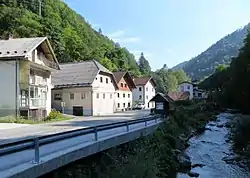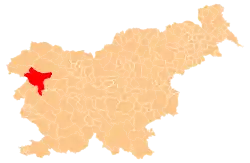Hudajužna
Hudajužna (pronounced [xudaˈjuːʒna]; Italian: Villa Iùsina[2]) is a village in the valley of the Bača River in the Municipality of Tolmin in the Littoral region of Slovenia.[3] The Bohinj Railway line runs through the settlement.
Hudajužna | |
|---|---|
 | |
 Hudajužna Location in Slovenia | |
| Coordinates: 46°10′37.89″N 13°55′7.5″E | |
| Country | |
| Traditional region | Slovenian Littoral |
| Statistical region | Gorizia |
| Municipality | Tolmin |
| Area | |
| • Total | 3.14 km2 (1.21 sq mi) |
| Elevation | 391.2 m (1,283.5 ft) |
| Population (2002) | |
| • Total | 119 |
| [1] | |
Name
The settlement was first attested in 1515 as Pochudauschna (and as Chuda Jusna in 1566, Cudaiusna in 1591, and per Hudeiusine in 1628). The name is a fused compound derived from *Huda južina (< hud 'intense, strong' + južina 'southern weather'), and thus refers to a local area that experienced the first significant thaw. The cadastral survey carried out under Emperor Francis I indicates that the name first referred to a rock shelter on Obloke Hill (Slovene: Obloški hrib) above the village, known as the place where the snow first melts away in spring.[4][5] The adjective hud also means 'bad' and the noun južina 'lunch', and so popular imagination has created a story about how the name refers to an Ottoman attack on the village while the villagers were having lunch.[4][6]
Church

The church in Hudajužna is dedicated to Saint Barbara. It was built in 1905 at the same time the railroad was built. It is a small building with a chancel walled on three sides and a nave through which the bell tower rises. It is roofed with sheet metal.[7]
Notable people
Notable people that were born or lived in Hudajužna include:
Gallery
 1915 postcard of Hudajužna
1915 postcard of Hudajužna
References
- Statistical Office of the Republic of Slovenia
- Venézia Giúlia e Dalmázia. 1934. Milan: Touring club italiano, p. 295.
- Tolmin municipal site
- Torkar, Silvo. 2003. "K nastanku in pomenu nekaterih zemljepisnih imen v Baški dolini / On the Origin and Meaning of Several Toponyms in the Bača Valley." Slavistična revija 51(4): 429–442.
- Snoj, Marko (2009). Etimološki slovar slovenskih zemljepisnih imen. Ljubljana: Modrijan. p. 165.
- Savnik, Roman (1968). Krajevni leksikon Slovenije, vol. 1. Ljubljana: Državna založba Slovenije. p. 404.
- Slovenian Ministry of Culture register of national heritage reference number ešd 3856.

